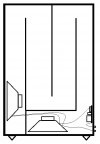The main point of a Transmission Line loudspeaker is that it's NOT tuned. ALL the rear radiation is absorbed in the line, so theoretically it doesn't matter if the line is open or closed. If closed, then any energy still remaining has to travel back through the absorption such that there's really nothing left to reach the back of the cone and colour the reproduction. That's the theory. In practice, few so-called TL loudspeakers are true TLs, and the clue there is the open vent at the front, as there's still LF energy left that by the time it gets out, and with correct dimensioning, the energy left has gone through a phase change (due to the wave velocity being slowed down by the line stuffing) that now reinforces the energy from the front of the cone, helping maintain bass output. B&W's Nautilus is one of the few true TL loudspeakers, and they're pretty big. The larger PMCs also are true TLs (or very close to it).
With a subwoofer, as you say, the wavelength at 20Hz is 56ft or around 17m and even folding that still makes for a very large loudspeaker. That's why I don't know of any commercial domestic subwoofer that uses TL loading. Any that claim to do so, won't be true TLs.
S.

